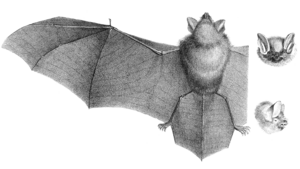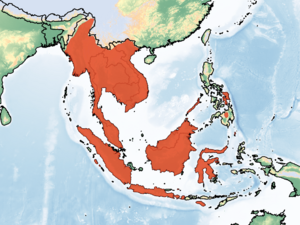Hardwicke's woolly bat facts for kids
Quick facts for kids Hardwicke's woolly bat |
|
|---|---|
 |
|
| Conservation status | |
| Scientific classification | |
| Genus: |
Kerivoula
|
| Species: |
hardwickii
|
 |
|
The Hardwicke's woolly bat (Kerivoula hardwickii) is a small bat. It belongs to a group called vesper bats. These bats are part of the Vespertilionidae family.
Contents
Where Do These Bats Live?
This bat lives in many parts of Asia. You can find it in countries like Bangladesh, China, India, Indonesia, Laos, Malaysia, Myanmar, Pakistan, Philippines, Sri Lanka, Thailand, Singapore, and Vietnam.
They can live in places as high as 2,500 meters (about 8,200 feet) above sea level. They also live in low areas, even 100 meters (about 330 feet) above sea level. Scientists believe there are many of these bats, and their numbers are staying steady.
What Kind of Home Do They Like?
In Southeast China, these bats are common in forests. However, we don't know much about their numbers in South Asia. In some warmer valleys of northeast Indonesia, and in rice fields in Sri Lanka, you might find them.
They often rest in caves and buildings found within forests. These bats mostly live in warm, wet areas called tropical and subtropical regions in China. But they also live in forests and on farms. Sometimes, they even fly into neighborhoods and rest on rooftops!
Hardwicke's woolly bats can live in many different kinds of forests. This includes old-growth forests, dry forests, and forests on hills or mountains. They have even been seen resting inside the leaves of rattan vines in Indonesia. In the Philippines, they have been found in thick bamboo patches.
These bats also live in the lower parts of forests, called the understory. They like to rest in hollow trees or in clumps of dead leaves. Like other bats that live in the understory, they fly slowly. This helps them move easily through the trees.
What Do Hardwicke's Woolly Bats Look Like?
The fur on the bat's back is usually a smoky brown color. Its belly is a lighter grayish-brown. The length of their forearm is usually about 31 to 36 millimeters (about 1.2 to 1.4 inches). Their ears are about 11 to 15 millimeters (about 0.4 to 0.6 inches) long.
This bat has a special feature: its premolar teeth are noticeably different in size. This is more obvious than in other Kerivoula species, like the painted bat. The skin of their wings is a dark brownish-black, but you can see through it a little. Their fur is very soft and not too long.
A Special Friendship with Plants
This small bat has a very interesting relationship with a special plant. It has been found resting above the digestive liquid inside the pitchers of a carnivorous plant called Nepenthes hemsleyana. This plant grows in swampy forests on the island of Borneo.
This relationship is a type of mutualism. This means both the bat and the plant help each other. The plant gives the bat a safe place to rest. In return, the bat's droppings (poop) fall into the pitcher. These droppings give the plant extra nitrogen, which is like food for it. Scientists think that about 34% of the plant's nitrogen comes from the bats' droppings!


